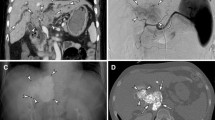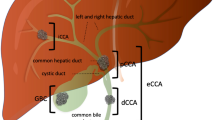Abstract
Purpose
To determine the necessity of preprocedural biliary drainage prior to chemoembolisation for hepatocellular carcinoma (HCC) with bile duct invasion.
Materials and Methods
The study included 52 patients who received chemoembolisation for unresectable HCC invading bile duct and causing hyperbilirubinemia (>3 mg/dL). Patients were divided into three groups according to biliary drainage and its effect: effective drainage (n=21), ineffective drainage (n=17), and non-drainage (n=14). Thirty-day mortality, length of hospitalisation, adverse events recorded using Common Terminology Criteria for Adverse Events (CTCAE), survival, and tumour response was compared among three groups.
Results
Thirty-day mortality rates were 14.3% (n=3), 17.6% (n=3), and 7.1% (n=1) for effective, ineffective, and non-drainage groups, respectively, and did not differ significantly among groups (p=0.780). The mean length of hospitalisation was shorter in non-drainage group compared to ineffective drainage group (12.1±11.4 vs 34.1±29.6 days, p=0.012). Mean differences in CTCAE grade for laboratory parameters before and after chemoembolisation were not significantly different among three groups. Survival among three groups was not significantly different (p=0.239–0.825). The tumour response was also not significantly different among three groups (p=0.679).
Conclusion
Biliary drainage may not be mandatory prior to chemoembolisation in patients with HCC invading the bile duct.
Key Points
• Chemoembolisation without biliary drainage can be performed for icteric HCC.
• Chemoembolisation without biliary drainage is not accompanied by increased adverse events.
• Preprocedural biliary drainage may not be mandatory for chemoembolisation for icteric HCC.





Similar content being viewed by others
References
Lin TY, Chen KM, Chen YR, Lin WS, Wang TH, Sung JL (1975) Icteric type hepatoma. Med Chir Dig 4:267–270
Kojiro M, Kawabata K, Kawano Y, Shirai F, Takemoto N, Nakashima T (1982) Hepatocellular carcinoma presenting as intrabile duct tumor growth: a clinicopathologic study of 24 cases. Cancer 49:2144–2147
Lau WY, Leow CK, Leung KL, Leung TW, Chan M, SC Y (2000) Cholangiographic features in the diagnosis and management of obstructive icteric type hepatocellular carcinoma. HPB Surg 11:299–306
Lai EC, Lau WY (2006) Hepatocellular carcinoma presenting with obstructive jaundice. ANZ J Surg 76:631–636
Huang JF, Wang LY, Lin ZY et al (2002) Incidence and clinical outcome of icteric type hepatocellular carcinoma. J Gastroenterol Hepatol 17:190–195
Shiomi M, Kamiya J, Nagino M et al (2001) Hepatocellular carcinoma with biliary tumor thrombi: aggressive operative approach after appropriate preoperative management. Surgery 129:692–698
Kim GM, Kim HC, Hur S, Lee M, Jae HJ, Chung JW (2016) Sloughing of biliary tumour ingrowth of hepatocellular carcinoma after chemoembolization. Eur Radiol 26:1760–1765
Bruix J, Sherman M (2011) Management of hepatocellular carcinoma: an update. Hepatology 53:1020–1022
Forner A, Gilabert M, Bruix J, Raoul JL (2014) Treatment of intermediate-stage hepatocellular carcinoma. Nat Rev Clin Oncol 11:525–535
Cho HC, Lee JK, Lee KH et al (2011) Are endoscopic or percutaneous biliary drainage effective for obstructive jaundice caused by hepatocellular carcinoma? Eur J Gastroenterol Hepatol 23:224–231
Choi J, Ryu JK, Lee SH et al (2013) Palliative treatment of unresectable hepatocellular carcinoma with obstructive jaundice using biliary drainage with subsequent transarterial chemoembolization. J Palliat Med 16:1026–1033
Chung JW, Park JH, Han JK et al (1996) Hepatic tumors: predisposing factors for complications of transcatheter oily chemoembolization. Radiology 198:33–40
Mondazzi L, Bottelli R, Brambilla G et al (1994) Transarterial oily chemoembolization for the treatment of hepatocellular carcinoma: a multivariate analysis of prognostic factors. Hepatology 19:1115–1123
Lee JW, Han JK, Kim TK et al (2002) Obstructive jaundice in hepatocellular carcinoma: response after percutaneous transhepatic biliary drainage and prognostic factors. Cardiovasc Intervent Radiol 25:176–179
Chung GE, Lee JH, Kim HY et al (2011) Transarterial chemoembolization can be safely performed in patients with hepatocellular carcinoma invading the main portal vein and may improve the overall survival. Radiology 258:627–634
Pinter M, Hucke F, Graziadei I et al (2012) Advanced-stage hepatocellular carcinoma: transarterial chemoembolization versus sorafenib. Radiology 263:590–599
Kothary N, Weintraub JL, Susman J, Rundback JH (2007) Transarterial chemoembolization for primary hepatocellular carcinoma in patients at high risk. J Vasc Interv Radiol 18:1517–1526 quiz 1527
Kim HC, Lee JH, Chung JW et al (2013) Transarterial chemoembolization with additional cisplatin infusion for hepatocellular carcinoma invading the hepatic vein. J Vasc Interv Radiol 24:274–283
Choi JW, Kim HC, Lee JH et al (2017) Transarterial chemoembolization of hepatocellular carcinoma with segmental portal vein tumour thrombus. Eur Radiol 27:1448–1458
Jung AY, Lee JM, Choi SH et al (2006) CT features of an intraductal polypoid mass: Differentiation between hepatocellular carcinoma with bile duct tumor invasion and intraductal papillary cholangiocarcinoma. J Comput Assist Tomogr 30:173–181
National Cancer Institute. Common terminology criteria for adverse events (CTCAE). version 4.03. http://evs.nci.nih.gov/ftp1/CTCAE/. Accessed July 26, 2016.
Leung DA, Goin JE, Sickles C, Raskay BJ, Soulen MC (2001) Determinants of postembolization syndrome after hepatic chemoembolization. J Vasc Interv Radiol 12:321–326
Lencioni R, Llovet JM (2010) Modified RECIST (mRECIST) assessment for hepatocellular carcinoma. Semin Liver Dis 30:52–60
Choi TW, Kim HC, Lee JH et al (2015) The safety and clinical outcomes of chemoembolization in child-pugh class C patients with hepatocellular carcinomas. Korean J Radiol 16:1283–1293
Kiely JM, Rilling WS, Touzios JG et al (2006) Chemoembolization in patients at high risk: results and complications. J Vasc Interv Radiol 17:47–53
Choi JW, Chung JW, Cho YK et al (2015) Transarterial Chemoembolization for Hepatocellular Carcinomas with Central Bile Duct Invasion: Safety, Prognosis, and Predictive Factors. Cardiovasc Intervent Radiol 38:937–945
Author information
Authors and Affiliations
Corresponding author
Ethics declarations
Guarantor
The scientific guarantor of this publication is Hyo-Cheol Kim.
Conflict of interest
The authors of this manuscript declare no relationships with any companies, whose products or services may be related to the subject matter of the article.
Funding
The authors state that this research was supported by a grant of the Korea Health Technology R&D Project through the Korea Health Industry Development Institute (KHIDI), funded by the Ministry of Health & Welfare, Republic of Korea (grant number : HI16C1753).
Statistics and biometry
No complex statistical methods were necessary for this paper.
Ethical approval
Institutional Review Board approval was obtained.
Informed consent
Requirement of written informed consent was waived by the Institutional Review Board.
Methodology
• retrospective
• observational
• performed at one institution
Rights and permissions
About this article
Cite this article
Park, J., Kim, HC., Lee, JH. et al. Chemoembolisation for hepatocellular carcinoma with bile duct invasion: is preprocedural biliary drainage mandatory? . Eur Radiol 28, 1540–1550 (2018). https://doi.org/10.1007/s00330-017-5110-7
Received:
Revised:
Accepted:
Published:
Issue Date:
DOI: https://doi.org/10.1007/s00330-017-5110-7




